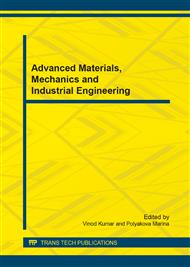p.627
p.633
p.638
p.643
p.647
p.652
p.656
p.661
p.667
Defects Reduction in Steering Gear Product Using Six Sigma Methodology
Abstract:
Lean Six Sigma is a disciplined data driven approach to improve the quality and the performance of a process or a system with which finally results to the profitability of a firm. Many of the organizations have adopted Six Sigma methodology to improve their quality and their performance to competitive industrial world. This work is concentrated with one of the leading Automotive component manufacturing company in South India. The main objective of this paper was to reduce the product defect with the application of Lean Six Sigma methodology. The paper follows the DMAIC methodology to investigate defects and its root causes and provide a solution to reduce and/or eliminate these defects. This paper also explores how a manufacturing process can use a systematic methodology to move towards world-class quality level.
Info:
Periodical:
Pages:
647-651
Citation:
Online since:
July 2014
Keywords:
Price:
Сopyright:
© 2014 Trans Tech Publications Ltd. All Rights Reserved
Share:
Citation:


